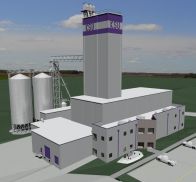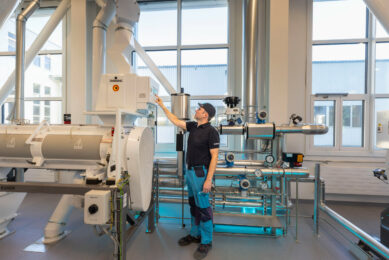K-State okays new feed mill

A new feed mill at Kansas State University will soon become a reality now that funding has been established.
Construction on the new O.H. Kruse mill is targeted to begin in late 2010 and should be completed in about a year, according to Keith Behnke, professor in K-State’s Department of Grain Science and Industry.
The mill will serve as the new home of the Feed Science and Management (FSM) program which has provided nearly 700 graduates to the USfeed manufacturing industry over the nearly 60 years since the industry helped to establish the program at K-State.
“Even though remodeled and updated numerous times, the present mill has far outlived its useful life and must be replaced,” Behnke said.
Bio and Agro Defence laboratory
Part of the impetus for the new feed mill is the selection of K-State/Manhattan as the site for the new $650 million National Bio- and Agro-Defense Facility (NBAF) laboratory to be built by the Department of Homeland Security.
NBAF will replace an aging BSL-3 (Bio-Safety Level 3) facility on Plum Island, NY.
The site chosen for NBAF is the current site of the K-State Department of Animal Sciences feed mill which, like its Grain Science counterpart, is well beyond its useful life, Behnke said. Prior to completion of NBAF, the ASI feed mill must be replaced.
$2 million gift
“The new feed mill and biorefinery complex is one of K-State’s top priorities,” said K-State president Kirk Schulz.
“With close to half of the necessary funding already raised or committed, we are enthusiastic about the new facilities which will benefit industry as well as our students.”
The Kruse family of Goshen, CA, has made a lead gift of $2 million to honour the company founder, O. H. Kruse, and to stress the importance of educating and training the next generation of feed and biofuels industry professionals.
The State of Kansas has committed to provide about half of the funding required for the new mill to replace the existing feed mill. Additional cash and in-kind equipment donations will provide the remaining resources needed for construction.
The decision was made by K-State officials to combine the feed-related activities of the Departments of Grain Science and Animal Sciences and build a single facility that will serve the teaching, research and outreach needs of both departments as well as the needs of the College of Agriculture in general, Behnke said.
Feed mill outline
What will ultimately be a $12.5 million facility will include a modern, automated 5-tonne-per-hour feed mill, a liquid feed research facility, and a BSL-2 teaching and research feed mill.
The mill is designed in such a way that scientists will be able to safely work with low virulence pathogens such as salmonella in feeds, but also use the facility for other research, teaching and outreach activities when not used in the BSL-2 mode.
Schulz noted that “with the new feed mill just across the street from NBAF, K-State can provide specialty livestock diets to support infectious disease experiments, oral vaccine studies and other trials under high level bio-safety controlled conditions. This work cannot be done anywhere else in the U.S.”
The preliminary design and cost estimate of the feed mill was provided by Younglove Construction, Sioux City, Iowa.
A feed mill design team made up of faculty members of both departments, as well as students, began working on the concept of a single facility nearly a year ago.
Buhler, Kahl and CPM inventory
The Buhler Corporation has agreed to install a vertical shaft hammermill for research and teaching as well, said Dirk Maier, head of the Department of Grain science and Industry.
“In addition to a traditional pelletmill, we will have a Kahl ‘flat-bed’ pelletmill that will be a technology platform for pelleting biomass for cellulosic biofuels research.
“Several devices, such as a Kahl expander and a CPM Hygenizer, will be available to conduct feed sterilization and sanitation research.”
Biorefinery
Because of long term interests in biofuels from cellulosic materials, there will be space in the new mill for a “semi-works” scale biorefinery.
While the biorefinery can use nearly any biomass as raw material, the current emphasis is on cheaper, renewable cellulosic material sources that will provide additional income prospects for US farmers and be socially and environmentally responsible regarding the use of grains for biofuels production.
The facility is also expected to include pilot-scale oilseed crushing and processing equipment.











